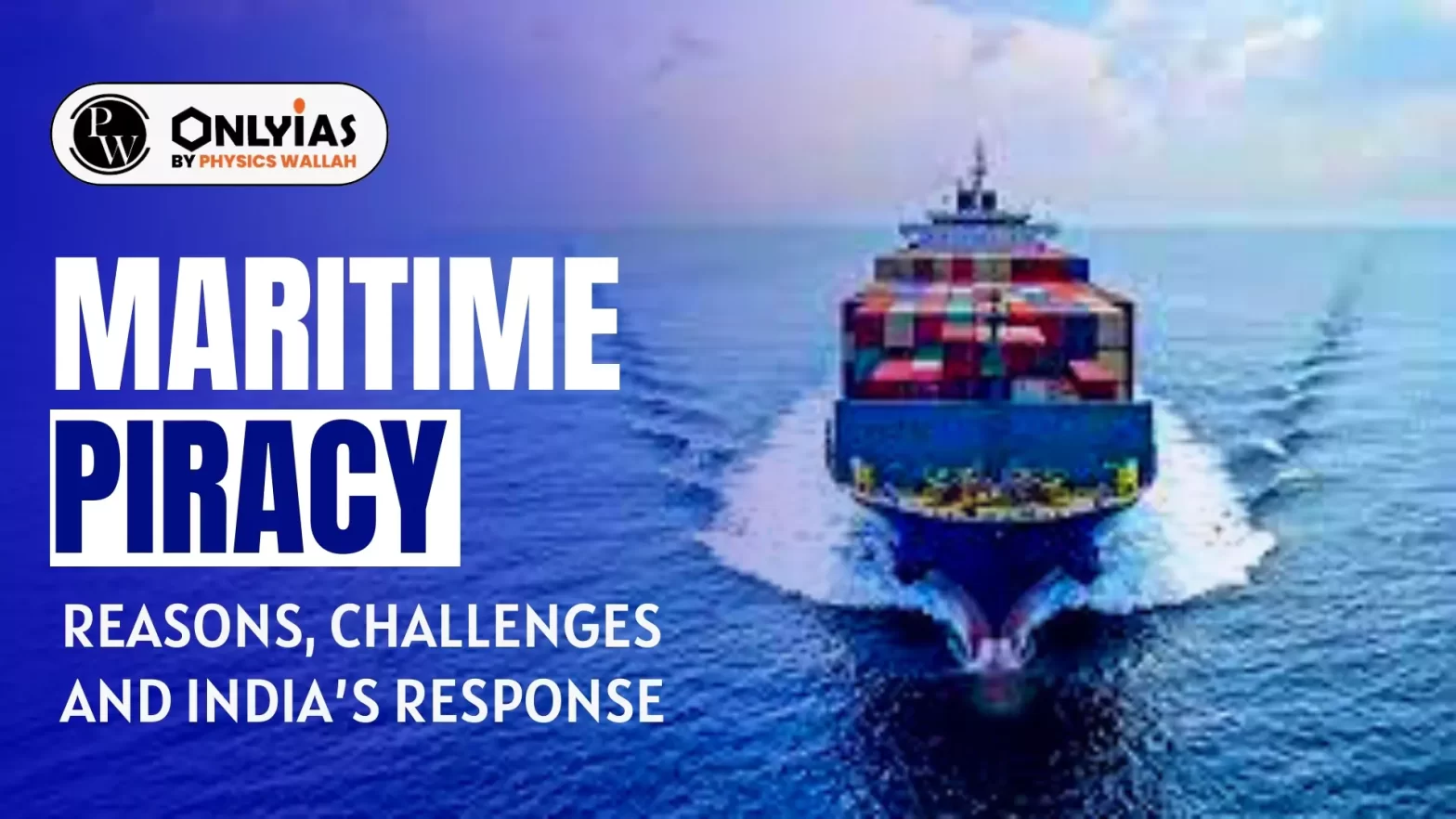Context:
This editorial is based on the news “The crime of piracy, and how maritime forces respond to it” which was published in the Indian Express. Recently, the Indian Navy thwarted two maritime piracy attempts off the Somali coast within a span of 36 hours.
| Relevancy for Prelims: Maritime Security, Indian Navy INS Sumitra, and Practice Maritime Intervention Operations (MIO).
Relevancy for Mains: Concerns with Maritime Piracy and Measures Required to Tackle it. |
What is Maritime Piracy?
- An Earlier Concept: It is as old as seafaring itself and has existed for centuries in various forms.
- Current Hotspots: In recent years, waters off the west coast of Africa, Gulf of Aden, Horn of Africa, Bangladesh, and the Strait of Malacca have seen attacks by pirates.
- A Range of Crimes: Maritime Piracy is an umbrella term used to describe a range of crimes from petty theft from ships at sea or anchorage to armed robbery and hijacking of a ship for ransom.
- Hijacking of a ship for ransom is the major concern, since it causes panic in maritime business and leads to the establishment of high-risk areas, and a resultant increase in maritime insurance premiums.
- It also affects the safety of ships and seafarers, and disrupts global supply chains.
- Concerning Statistics of Maritime Piracy: As per the International Chamber of Commerce International Maritime Bureau, which tracks maritime piracy attacks globally,
-
- The total number of attacks in the Indian Ocean region attributed to Somali pirates peaked in 2011 with 237 recorded incidents with gunmen launching attacks as far as 3,655 kilometers (2,270 miles) from the Somali coast in the Indian Ocean.
- But saw a drastic decline to 14 between 2015 and 2020 after international navies sent warships and commercial shipping deployed armed guards.
Reason of Maritime Piracy in Current Areas
- Poor Policing: The coastal countries have weak maritime forces, or none at all.
- Shipping Choke Points: The areas have high concentrations of shipping traffic, being either choke points in shipping routes where ships are forced to converge or slow down by geography, or anchorages where ships remain stationary for days before entering port.
- Poor Law and Order situation: Poor governance or turmoil on land close to these areas leads to unemployment, poverty and consequently, crime.
- Jurisdictional Ambiguities: These areas are mostly international waters, international straits, or archipelagic waters which are long stretches of sea that fall within the maritime jurisdiction of several countries.
Challenges to Counter Maritime Piracy
- Inadequate National Laws: National laws are often inadequate to deal with apprehended pirates.
- Ineffective International Mechanism: There is no effective international legal mechanism for trial and disposal of pirates.
- Complex Jurisdictional Issues: Many nationalities, countries, maritime zones, flag states, etc. involved raise complex jurisdictional issues.
Role of Indian Navy to Counter Maritime Piracy Challenges
- The Indian Navy has been among the most proactive forces deployed in the troubled area off the Horn of Africa and the Gulf of Aden with its anti- maritime piracy starting from 2008.
- Maritime Intervention Operations (MIO): The Indian Navy has developed extremely high expertise in this niche area of naval operations using marine commandos in intervention operations.
- Achievement: Rescue of a Sri Lankan fishing trawler, Lorenzo Putha, in a coordinated action with the Sri Lankan and Seychelles navies on January 29.
-
- Rescue of two Iranian flagged boats with Iranian and Pakistani crew by the Offshore Patrol Vessel INS Sumitra within 36 hours.
Measures Needed For Anti-Maritime Piracy Response
- Visible Presence: Maritime forces need to maintain a visible presence that aims to deter pirates from carrying out attacks.
- Surveillance: Maritime forces need to undertake surveillance of the high-risk area, identify suspect vessels, and report them for further investigation. This is supported by information fusion centers ashore.
- Provide Necessary Warnings: Maritime forces need to warn passing ships about suspect vessels and announce escort schedules, if any, so that merchant ships transiting the high-risk area can join convoys between designated points.
- Proactive Intervention: Maritime forces need to proactively or reactively intervene to manage a developing situation, foil a piracy attempt, or rescue a hijacked vessel while trying to ensure minimum casualties and damage.
- Practice Maritime Intervention Operations (MIO): Marine commandos are the most effective in intervention operations. The Indian Navy has developed extremely high expertise in MIO.
- Once the pirates have been overcome by the commandos, the crew is released from the safe zone on board.
- Be a Part of Coalition: Naval ships can operate as part of a US-coordinated maritime coalition of forces, led by rotation by a commander of one of the participating forces.
- They use a common communication protocol, maintain presence, and share information to thwart piracy attempts. Surveillance aircraft also form part of this coalition force.
- Some nations prefer to operate independently.
- Need of Effective Communication: The effective communication among all maritime forces is a need of the hour.
- Communications with merchant vessels are maintained on commercial open frequencies that are known to all seafarers and commercial aircraft.
- Interoperability: A ship with an armed helicopter is the most effective in dealing with a maritime piracy situation because of its rapid response capability in reaching the spot, directing fire, and vectoring the nearest ship that can render assistance.
Conclusion
A long-term solution to the problem of maritime piracy requires countering misgovernance and unemployment in nations ashore, which feed maritime criminal activities. Till that happens, piracy will recur periodically and maritime forces will have to work to ensure mercantile peace.
Also Read: Red Sea Crisis
![]() 3 Feb 2024
3 Feb 2024

